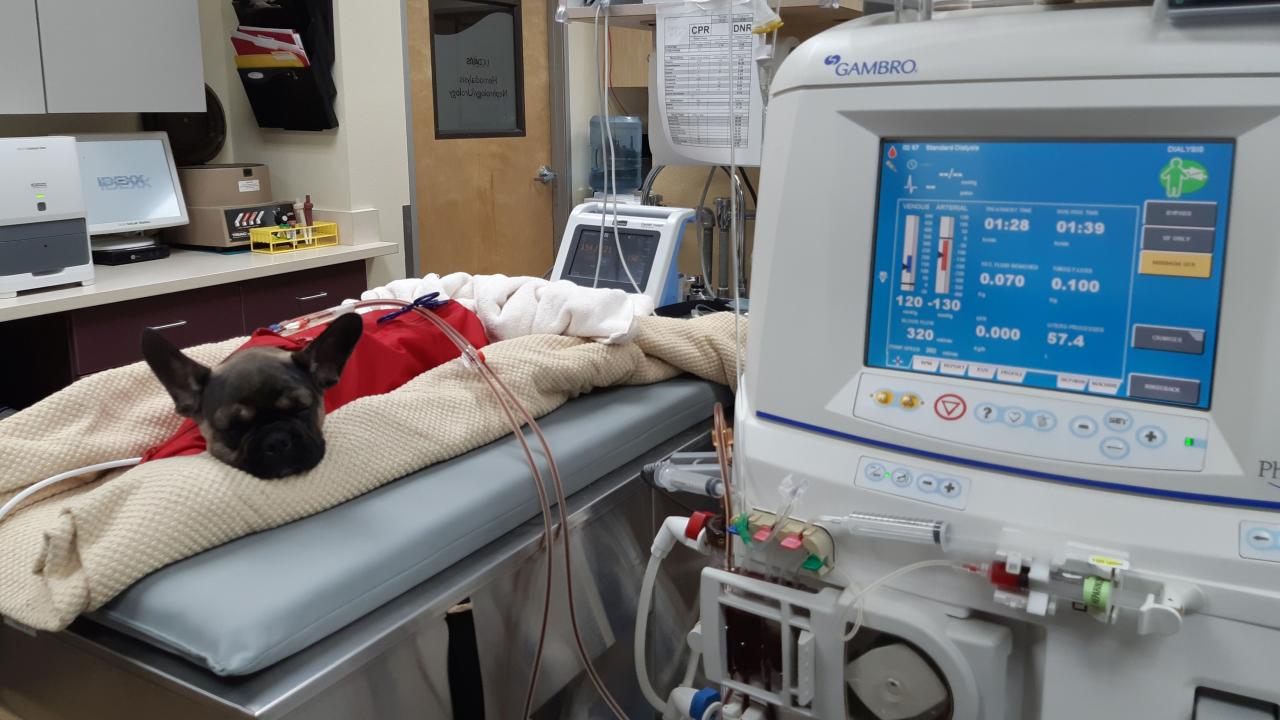
Hemodialysis Available for Southern California Patients
***This article originally appeared in the February 2021 issue of Pulse magazine.***
Hemodialysis is available for Southern California patients at the UC Veterinary Medical Center – San Diego (UCVMC-SD), a satellite facility of the UC Davis Veterinary Medical Teaching Hospital. Since 2002, the Advanced Extracorporeal (Hemodialysis) and Urinary Disease Service at UCVMC-SD has been treating life-threatening acute kidney failure and managing long-term renal conditions. Nephrology and urology expertise for less critical conditions is also available. The service also supports a unique fellowship program at UCVMC-SD to expand advanced training in this growing discipline.
Hemodialysis enables the removal of metabolic solute and fluid waste from the bloodstream of an animal by allowing those wastes to diffuse out of the blood across many semi-permeable, biocompatible membranes. The dialysis machine pumps blood from the patient through a dialyzer (artificial kidney) outside the body and then pumps the purified blood back to the patient. These processes happen simultaneously and continuously throughout a 3- to 6-hour treatment session.
A dialysis candidate may be any patient with acute uremia or oligoanuria unresponsive to medical management. In addition to treating severe azotemia, dialysis can correct severe hyperkalemia, acidemia and volume overload during the course of a treatment. Usually, three treatments given on consecutive days are required: to safely treat a severely azotemic animal; to avoid sudden, extreme osmotic shifts; and to permit the brain to adapt to osmotic changes.
Common reasons for dialysis referral in veterinary medicine include ethylene glycol ingestion, leptospirosis (dogs), ureteral obstruction (cats), pyelonephritis, conditioning for transplantation, acute renal failure from systemic disease (e.g., pancreatitis), and acute uremia of unknown cause. UCVMC-SD especially encourages referral of acute (within 12 hours of ingestion) ethylene glycol ingestion. In many of these patients, dialysis can quickly and thoroughly remove ethylene glycol and its nephrotoxic metabolites from the bloodstream before renal damage occurs, at a comparable cost to hospitalization and 4-MP therapy.
Dialysis is an outstanding intervention in many acute poisonings. Some drugs such as aspirin, acetaminophen and many prescription medications will diffuse through the dialyzer membrane and thus can be removed directly from the bloodstream. We can also remove many non-dialyzable substances via an adsorption process called hemoperfusion. For hemoperfusion techniques, a canister of adsorbent charcoal or polystyrene beads is added in circuit with the dialyzer.
Please call UCVMC-SD (858-875-7505) early in the course of patient management. UC Davis veterinarians encourage consultation as soon as you suspect a patient might benefit from extracorporeal therapy; delay in instituting therapy for a pet with acute renal failure can jeopardize a successful outcome. The faculty are always happy to discuss cases, whether or not they are eventually referred.
Spare the jugulars! Successful dialysis treatment requires high blood flow rates (5-50 ml/minute for a cat, 25-350 ml/minute for a dog), which necessitates placement of a very large-gauge jugular catheter. Therefore, UCVMC-SD asks that you avoid jugular venipuncture and jugular catheters whenever possible in a potential referral to help ensure a routine, percutaneous catheter placement avoiding a more complicated, surgical placement with general anesthesia.
UCVMC-SD feels strongly about talking to clients personally before they arrive for a dialysis appointment, so please involve them in the referral process. Hemodialysis is intensive and can be quite expensive. It is important to ensure that clients understand the financial and emotional commitment involved with dialysis, as well as the potential benefits and limitations of therapy for a particular pet’s illness.
